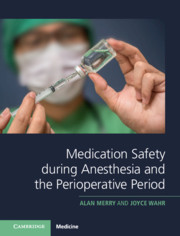Book contents
- Medication Safety during Anesthesia and the Perioperative Period
- Medication Safety during Anesthesia and the Perioperative Period
- Copyright page
- Dedication
- The Snow Vaporizer, Mark II
- Contents
- Foreword
- Acknowledgments
- 1 Introduction to Medication Safety in Anesthesia and the Perioperative Period
- 2 Failures in Medication Safety during Anesthesia and the Perioperative Period
- 3 Failures in Medication Safety in the Intensive Care Unit and Ward
- 4 Impact of Medication Errors on the Patient and Family
- 5 Consequences for the Practitioner
- 6 Why Failures Occur in the Safe Management of Medications
- 7 Errors in the Context of the Perioperative Administration of Medications
- 8 Violations and Medication Safety
- 9 Interventions to Improve Medication Safety
- 10 Medication Safety in Special Contexts
- 11 Legal and Regulatory Responses to Avoidable Adverse Medication Events, Part I: General Principles
- 12 Legal and Regulatory Responses to Avoidable Adverse Medication Events, Part II: Practical Examples
- 13 Barriers to Improving Medication Safety
- 14 Conclusions
- Index
- References
2 - Failures in Medication Safety during Anesthesia and the Perioperative Period
Published online by Cambridge University Press: 09 April 2021
- Medication Safety during Anesthesia and the Perioperative Period
- Medication Safety during Anesthesia and the Perioperative Period
- Copyright page
- Dedication
- The Snow Vaporizer, Mark II
- Contents
- Foreword
- Acknowledgments
- 1 Introduction to Medication Safety in Anesthesia and the Perioperative Period
- 2 Failures in Medication Safety during Anesthesia and the Perioperative Period
- 3 Failures in Medication Safety in the Intensive Care Unit and Ward
- 4 Impact of Medication Errors on the Patient and Family
- 5 Consequences for the Practitioner
- 6 Why Failures Occur in the Safe Management of Medications
- 7 Errors in the Context of the Perioperative Administration of Medications
- 8 Violations and Medication Safety
- 9 Interventions to Improve Medication Safety
- 10 Medication Safety in Special Contexts
- 11 Legal and Regulatory Responses to Avoidable Adverse Medication Events, Part I: General Principles
- 12 Legal and Regulatory Responses to Avoidable Adverse Medication Events, Part II: Practical Examples
- 13 Barriers to Improving Medication Safety
- 14 Conclusions
- Index
- References
Summary
Surgical patients undergo multiple transitions of care, from home to the operating room, to a recovery unit to a ward, and so on. Each transition poses a risk of medication error if the current medications are not reconciled or managed appropriately in the new phase of care. Home medications may be suspended, stopped, substituted for, or need to be continued, often in the face of changing preoperative guidelines. Admission and discharge medication reconciliations are at high risk for inaccuracies and for mis-information for the patient as well as the patient's primary provider. Intraoperative medication management is largely but not exclusively, under the control of the anesthesiologist, who serves as the sole agent for the prescription, dispensing, preparation, administration, documentation and monitoring of the anesthetic medications. Common errors include syringe or vial swaps, omissions (e.g., no redosing of antibiotics), wrong route, wrong dose, and even wrong choice of medication. Medication errors occur in approximately every 2 anesthetics, most are of little to no harm, but each has the potential for significant injury. Medication errors also can be made by a surgeon or OR nurse; communication failures between care team members often contribute.
Keywords
- Type
- Chapter
- Information
- Publisher: Cambridge University PressPrint publication year: 2021

